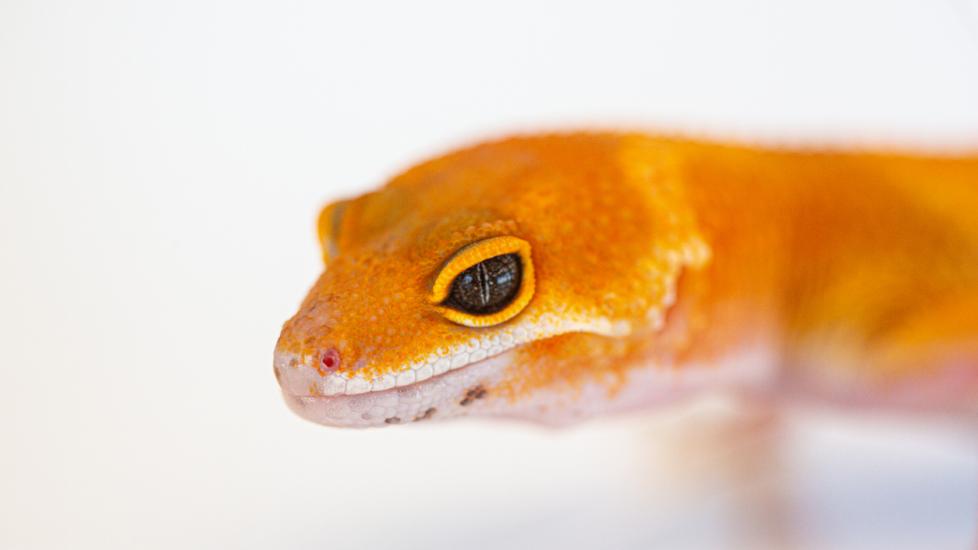Types of Leopard Geckos
Leopard geckos are docile and fun beginner reptiles that often come in bright, bold, and beautiful colors. They rarely bite and can live upwards of 20 years with proper care. Most of the leopard geckos in the pet trade are bred in captivity.
As leopard geckos become more popular, breeders have selectively bred different types or “morphs” with unique colors and patterns. Although these morphs may look different from the common leopard gecko, they are all the same species, Eublepharis macularis. Other leopard gecko species are less commonly kept as pets and include the West Indian leopard gecko (Eublepharis fuscus) and the East Indian leopard gecko (Eublepharis turcmenicus).
What Does a Normal Leopard Gecko Look Like?
The wild or common leopard gecko is yellow with a pattern of dark brown or black spots—similar to the spots on a leopard. These areas of dark pigment are banded in juveniles and more spotted in adults. In the wild, this species is found in the Middle East and Asia. Living in these arid and semi-arid environments, the geckos use their coloration as camouflage—hiding from predators (foxes, snakes, and other reptiles) in the rocky clay-gravel soils. They may burrow during the day to escape the sun and became more active at dawn and dusk.
Leopard geckos are one of the most common pet reptiles, second only to bearded dragons. They were likely one of the first reptile species to become domesticated in the 1970s. Adult wild-type and common leopard geckos are typically between 6.5 and 8 inches long. Adult males weigh more than females—between 2 and 3 ounces, while females weigh as little as 1.5 ounces.
Leopard Gecko Morphs
A morph is a leopard gecko with any variation in color, pattern, or size other than the typical yellow with black spots. Gecko breeders began to use selective breeding to produce new colors and patterns in the 1990s. By specifically mating geckos with certain color and pattern combinations, reptile breeders can include or exclude certain traits. There are now over 100 different types of morphs. In general, the larger the morph and the more vivid the color, the more expensive and rarer the gecko will be.
Reptile breeders will typically use six general classifications when describing leopard gecko morphs:
-
Giants are larger in size—they may be up to 2 inches longer than normal geckos measuring up to 10 inches in length and weighing over 3.5 ounces. They can come in any color pattern. A special type of giant, called the Super Giant, can reach lengths of nearly 12 inches.
-
Eye morphs have different color or shape of the eye.
-
Albinos are very light in color and lack certain enzymes. They can still display patterns.
-
Blizzards are solid colors and completely patternless with black eyes. They may be white, yellow, or even purple.
-
Melanistics have differing levels of pigment, which are color-producing cells. “Hypos” produce less melanin, while “hypers” produce more melanin.
-
Striped geckos have banded patterns instead of spots.
Common specific color and pattern morphs include:
-
Aberrant morphs have breaks in their pattern. This may result in some spots with larger bands or stripes.
-
High Yellow morphs are very similar to wild-type leopard geckos but have a more vivid yellow and fewer spots.
-
Baldy geckos have no spots on their head.
-
Black Night morphs are melanistic and come in a solid black back with a white abdomen. These are some of the rarest leopard geckos.
-
Mack Snow geckos are either white or pale yellow with dark bands and spots.
-
Diablo Blanco is a combination of a Raptor and blizzard leopard gecko. These morphs are solid white with red eyes.
-
RAPTOR stands for Red-eye Albino Patternless Tremper Orange. They have solid orange bodies with red eyes.
-
Tangerines have bright orange coloration with brown spots on their tail.
-
Carrot tails have at least 15% of the tail covered in orange.
-
Lavender morphs display a light violet color but may fade as they get older.
It is important to find a reputable leopard gecko breeder who understands genetics and breeds for the health of the species. Some morphs may require additional veterinary care, so work with your veterinarian to determine the specific needs of your leopard gecko.
References
-
David, Jonathan. Everything Reptiles. Best 50 Leopard Gecko Morphs: Color List & Pictures.
-
Pollock DVM, DABVP, Christal. LafeberVet. Basic Information Sheet: Leopard Gecko.
-
Kruzer, Adrienne. The Spruce Pets. Types of Leopard Gecko Morphs.
Featured Image: iStock.com/Cavan Images
